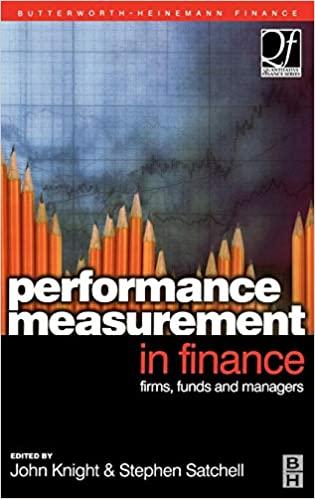Question
With explanation 1. The overall cost of long-term financing for the firm is called the: a. Weighted average cost of capital b. Cost of preferred
With explanation
1. The overall cost of long-term financing for the firm is called the:
a. Weighted average cost of capital
b. Cost of preferred stock
c. Retained earnings breakpoint
d. None of the given choices
2. The overall weighted average cost of capital is used instead of costs for specific sources of funds because
a. The use of the cost for specific sources of capital would make investment decisions inconsistent
b. A project with the highest return would always be accepted under the specific cost criteria
c. An investment funded by equity or debt is not relevant to this question
d. None of the given choices
3. Which of the following is not a component used in calculating the cost of capital?
a. Cost of short-term debt
b. Cost of long-term debt
c. Cost of common stock
d. Cost retained earnings
4. the most expensive source of financing for a firm is
a. Debt
b. Preferred stock
c. Retained earnings
d. New common stock
5. The cost of capital at the retained earnings breakpoint is the
a. Weighted average cost of capital
b. Marginal cost of capital
c. Cost of new stock
d. None of the given choices
6. Which of the following is not associated with the cost of capital concept?
a. Minimum rate of return on new projects
b. Weighted average of cost of new funds raised
c. The required rate of return of investors
d. The historical cost of funds
7. Which of the following is likely to increase a firms cost of capital?
a. Increasing the proportion of equity in the firm
b. Increasing the proportion of debt in the firm
c. The consideration of a below-average risk project
d. Expectation of lower inflation in the future
8. If a firm uses the same company cost of capital for evaluating all projects, which of the following is likely?
a. Rejecting good low-risk projects
b. Accepting poor high-risk projects
c. Both choices are correct
d. Neither of the choices is correct
9. The use of the companys cost of capital as the discount rate for a capital budgeting proposal is inappropriate if
a. It calculates a negative NPV for the proposal
b. The proposal has a different degree of risk
c. The company has unique risk
d. The company expects to earn more than the risk-free rate
10. In general, it is more expensive for a company to finance with equity than with debt because
a. Long-term bonds have a maturity data and must, therefore, be repaid in the future
b. Investors are exposed to greater risk with equity capital
c. The interest on debt is a legal obligation
d. Equity capital is in greater demand than debt capital
11. If nominal interest rates increase substantially but expected future earnings and dividend growth for a firm over the long run are not expected to change, the firms stock price will
a. Increase
b. Decrease
c. Stay constant
d. Change, but in no determinable direction
12. In practice, dividends
a. Usually exhibit greater stability than earnings
b. Fluctuate more widely than earnings
c. Tend to be a lower percentage of earnings for mature firms
d. Are usually changed every year to reflect earnings changes
Step by Step Solution
There are 3 Steps involved in it
Step: 1

Get Instant Access to Expert-Tailored Solutions
See step-by-step solutions with expert insights and AI powered tools for academic success
Step: 2

Step: 3

Ace Your Homework with AI
Get the answers you need in no time with our AI-driven, step-by-step assistance
Get Started


